
River Camp III to Peacock Slough River Camp, March 10, 2009: It was a long night. As I’ve already said, we were driven into our tents at dusk by little black mosquitoes with a nasty bite! So I sat in my tent reading about cadavers as crash test dummies till my eyes began to sag. I turned off my headlamp and stretched out on top of my Big Agnes bag and pad. As it was a warm night, I decided to leave the vestibule flaps rolled back. It was such a treat to be here like this, sort of stealing a preview of summer and the months to come. I drifted off with the full moon lighting the inside of the tent, through the open vestibule.
The howling of coyotes woke me around one o’clock. They were way off somewhere. The moon had moved a great distance in the night sky. I felt a light breeze stir and drift through the tent. It was getting a little cooler, so I climbed into my sleeping bag and drifted off once more, to a lullaby sung by a far off, wild chorus.
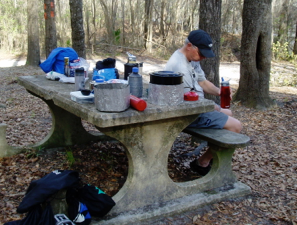
I awoke again around five o’clock, this time because the temperature had dropped significantly, and I was cold. I pulled on my watch cap and a light polartec sweater, snuggled down in my bag and tried to go back to sleep for a third time. I wasn’t really sleepy anymore. After all, I’d already been in my sleeping bag for eight hours. Still, it was dark and cold, so I stayed put. A Barred Owl let loose with a blood curdling scream somewhere close by. I’m glad I knew what it was. Still, in the dark and cold of the early hours of the morning, it made the hair stand up on the back of my neck!
At seven, it was still dark. I got up anyway, dressed, and began to pack up the gear inside my tent. A half-hour later it was light enough to crawl out to see what the day might bring. Scott and John had begun to stir as well. We knocked down the tents and munched bananas and granola bars for a quick breakfast. We were on the water sometime after 8:30 am.
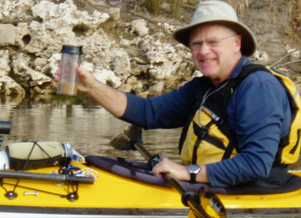
The picture on the right shows Yackman with his morning coffee in hand on the river. He improvised a cup holder on deck to get the last of his morning wake-up.
The river here is wider than at Suwannee Valley, probably twice as wide. The shoreline is more regular, with fewer twists and turns. There are fewer limestone rock formations and almost no sandbars. We had the feeling that we were paddling into springtime. The trees and bushes that had been bare at the start of our trip, now exploded with buds, flowers, and the beginnings of leaves in that beautifully delicate new green of springtime.
Rounding a long bend in the river, we came upon a “wake” of vultures. (OK, it was a flock of vultures. But it seems to me that if a flock of owls is called a parliament, then a flock of vultures ought to be called a wake.) There were dozens of them. They were marching along the shore. They were perched on driftwood. They watched from high in the trees on each side of the river. Their bald heads and crooked necks followed us, staring coldly with beady red eyes. They stood like sentinels, watchmen along the River Styx flowing slowly toward the Gates of Hell. I was glad to leave that part of the river behind us!
Beside the vultures, we saw more Kingfishers and turtles, a pair of Cardinals, and Sturgeon breaking the surface of the river. Other unidentified fish jumped clear of the water, traveling several feet before dropping back with a loud plop. There were several hawks that we couldn’t identify and a gator. This guy was sunning himself several feet up on a steep sandbar, one of the few sandbars we would see that day. He was about six feet long and had a smooth deep gray hide. He looked very healthy. Scott and I noticed him at once, but John was closest. However, he was somewhere inside himself, lost in the hypnotic rhythm of his paddling and his own thoughts. He never saw it as it dove off the bank behind his boat and disappeared.
Our destination today was Peacock Slough (pronounced “Sloo”) River Camp, the third and last of the river camps we would stay at on this trip. Along the way we passed Dowling Park, a.k.a. Advent Christian Village, which offers paddlers lodging (but not camping) and Lafayette Blue Springs State Park, that offers camping and more. We had reservations at Lafayette Blue Springs, but like yesterday, we elected to by-pass this stop and press on to Peacock Slough to even out each day’s paddling mileage.
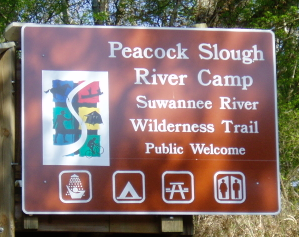
We reached Peacock Slough River Camp late in the afternoon. We had covered 23.5 miles. At 75.5 miles total distance paddled, we were a little more than half of the distance to our end point, Fanning Springs State Park. The landing at Peacock Slough is excellent. There is a low, wide beach on both sides of the stairway leading into the camp. From the bottom of the stairs to the water’s edge is a matt embedded in the sand that makes dragging a boat from the water to the stairs an easy task that won’t damage the boat. To the north of the landing, the slough meets the river with a rush, creating the satisfying sound of moving water. The setting from the landing on the stairway above is beautiful. We all spent some time standing there, watching the afternoon sun shine through the trees behind us and throw sparkles on the water where the slough met the river.
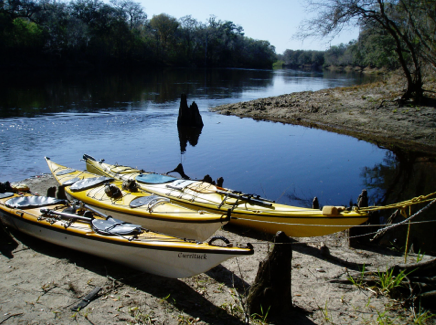
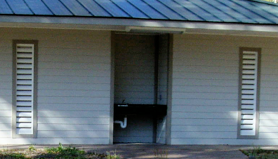
Peacock Slough appeared to be the newest of the camps we visited. The bathhouse was enormous and was air-conditioned. Outside was a lighted area with hot water for washing dishes – what a luxury! We went to find the camp host and soon spotted the usual RV parked at the back of the camp. As we approached there was a flurry of activity from inside the vehicle as a large black dog exploded out from under the RV, making it clear that we had better not take another step, Gee (pronounced with a hard “G” sound) called the dog and put him in the RV.
Gee, the camp host, was a single woman from Quebec who was volunteering her time as camp host in exchange for being allowed to stay at the site for the winter. The dog was her protector. We nicknamed him “Killer”. It was clear that no one would get by Killer if Gee didn’t want him to. There was plenty of room in camp (we were the only campers again), we were welcome to stay, and the price was right – free! Scott asked Gee if she knew of any “informal” camping spots along the river, south of Branford. We needed a good unofficial river camp for tomorrow night. She did not, but offered to bring an outfitter friend to talk to us when he arrived later that day.
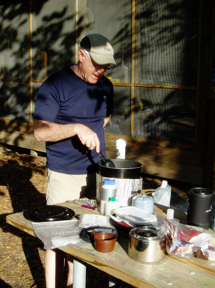
We set up camp and and Yackman started dinner when Gee and her friend showed up. The outfitter friend said the thought there was a sandbar beyond Branford, but wasn’t sure just where. Then Gee and her friend, and we hoped Killer, departed, not to be seen again, by us anyway. Dinner was Pad Thai. Excellent after a long paddle! After clean-up, we talked for awhile. Then each one of us went off to call home, as we had good cell phone reception here.
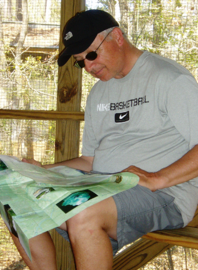
Sitting in the campfire area, I talked with Lisa for quite a while, then wandered back to camp as the mosquitoes came out in force. As darkness fell, we could hear by his soft snoring that John had left us. Soon Scott was hunkered down in his sleeping bag with Napoleon and Josephine, while I completed my daily journal entry. When I finished I picked up my book and turned to tonight’s chapter: The Cadaver Who Joined the Army. What?
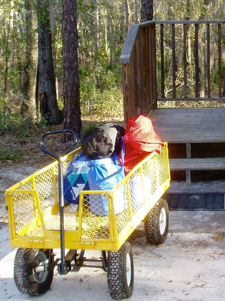
The River Camp Gear Cart: Each River Camp has a sturdy gear cart that is usually found at the top of the stairs at every river camp landing. Since the camp is often quite a distance from the landing, these carts are a wonderful tool for hauling gear to and from the water. Picture

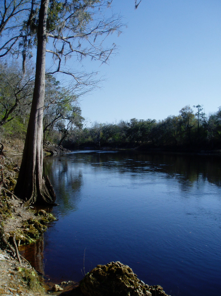
Peacock River Slough River Camp to River Camp V, March 11, 2009: The night started off warm, but then cooled enough to make it comfortable in our sleeping bags. I read till 10:00 pm, and then quickly went to sleep. I rolled over about one o’clock to see the light of the full moon streaming through our platform and didn’t awake again till about five, when the cold sent me looking for my watch cap again. At seven I was ready to get up, but it was still dark. So a lay there for awhile, finally crawling out at seven-thirty. We all packed quickly and had a fast breakfast of granola bars and bananas. The boats were loaded and we were on the water by 8:50 am.
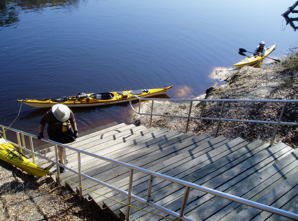
By 11:30 we had paddled twelve miles. We were scheduled to stay at Adams Tract River Camp, but were now planning to by-pass this camp as well, and camp along the river. We decided to stop and check out Adams Tract and tell the host that we would not be staying there. The landing at Adams tract is the worst we had come upon. The bottom several stairs were under water and there was no beach. Scott managed to slide his boat along the steps into some brush and shallower water and get out there. There was no other space like that available, so I gingerly eased my boat parallel to the steps, braced against them with my paddle and made a somewhat less than graceful exit. There was no place to pull my boat out, so I tied it off using my bow line. John decided to avoid these problems by waiting in his boat.
Adams Tract was similar to the other river camps, although the bathroom facilities were much less elegant. I’m not sure how the planners decide which camp gets what facilities. While basically the same, they are all different in specific details. We met the camp host and informed him that we wouldn’t be staying that night. This didn’t upset him as it freed him to go paddling in his new kayak. When asked about river camping beyond Branford, he said there was a large sandbar about three miles south of the town in the eastern shore. We thanked him, got back into our boats and paddled off.
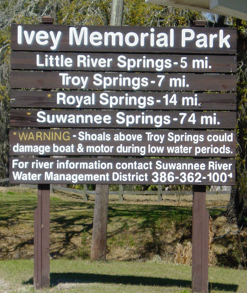
Soon Branford and Ivy Memorial Park came into view. It was still early, so we decided to take an extended lunch break here and see if we could re-supply some of our lunch fixings, as we were running low. From the river, Branford seemed like a scruffy little town. The park was pleasant, but kind of crudely made with picnic tables and shelters all made out of concrete. This seemed odd. Then we saw the pole that marked the heights of different floods that had hit the area. The highest mark at 37 feet was way above our heads. It would have covered everything in the park ad pushed way into town. It was sobering to think that this placid river could rise that much and potentially do so much damage.
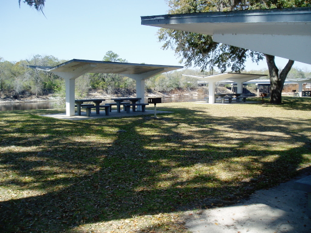
After lunch, we walked over to the local Kwik-Mart where we picked up peanut butter and bread for lunches. Then we each grabbed a cool drink and two ice cream bars. Did I mention it was hot? At the checkout were three of the largest folks I’d seen in a while. Two were young, one was middle-aged, and all were female. We later speculated that beauty in Branford must be judged by the pound!
Around two o’clock we got back on the water after spending two hours in Branford. About three miles below Branford the river doubles back on itself in a 270-degree turn. On the backside of that turn is an enormous sand bar, twenty or more feet high, 300 feet deep, and perhaps 1000 feet long. It sat there, inviting us, shining beautifully in the afternoon sun. This would be our camp tonight.
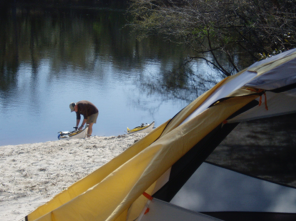
Landing was easy. We pulled our boats up and carried them close to a clump of bushes that we could tie off to. The three of us climbed the sandbar to the top, scouting the area for appropriate places to put tents and our kitchen. Soon each of us had staked out our spots. Scott claimed the low area to our west as the kitchen. It was sheltered under some trees, flat, and less sandy than some of the other areas. We started hauling gear from the boats. It was not an easy task. With each step forward up the hill you sank into the sand and slid back a half step. Soon our tents were set and made ready for the night. The kitchen was set up, waiting for the cook to appear.
Scott and I got so hot unloading the boats and setting up camp that we decided to get wet in the Suwannee. Scott used the excuse that his paddling gear needed a good washing, so he gingerly dropped into the water and immediately proclaimed it “chilly”! It was March 13th, and we were in northern Florida. Even though the river is fed by springs whose temperature is a constant 720, other water flowing into the Suwannee isn’t as warm. I quickly joined Scott and agreed that it was indeed chilly, but refreshing and just what I needed. While we were cooling off, John was setting up his tent and making side comments. He didn’t want to try out the water that day. We didn’t linger in the water for long, as this is alligator country. We hadn’t seen many gators on the river, but wherever there is fresh water in Florida, there are gators. And it’s the ones you don’t see that get you!
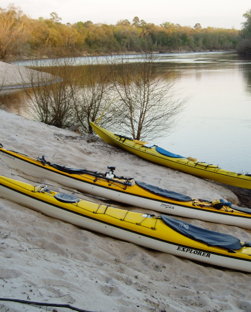
After swimming and drying off some, I put my Crazy Creek chair in the shade next to my tent and relaxed, watching the river. The tent sat at the top of the sandbar, back against some low trees and brush. I had an unobstructed view down river to where it finally turned a corner and flowed out of sight. It was peaceful and beautiful. Scott and John soon joined me. But sitting was bothering John’s back, so after a while, he went to his tent and stretched out. For a long time Scott and I sat watching the river, occasionally talking, but mostly drinking in the elemental beauty and peace of the place. For me it was the best part of the whole trip.
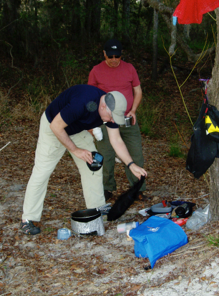
That night’s meal was an experiment. None of us had ever used these ingredients together before. Five days into a trip it is nearly impossible to prepare anything with fresh meat or vegetables. Our meal would be freshly made, that is not a dehydrated meal in a bag, but without the perishables. Tonight we would have Rotini with Barilla marinara sauce and Bridgeford Party Bites sausages. The great thing was that the sauce came in a bag and so did the sausages – easy to pack and they needed no refrigeration! It was an easy, hearty and really good dinner!
After dinner, John and I washed the dishes and cook pots. Then we all sat for a while longer, until dusk settled around us and the mosquitoes drove us into our tents once more. The night promised to be warm and pleasant. I left the vestibule doors tied back so that I could feel the slight breeze and see the river in the moonlight. After completing my journal entries and trying to read about cadavers and crucifixion experiments, I climbed into my sleeping bag and fell asleep. It was about ten o’clock.

Commando River Camp V, On the Sand Bar
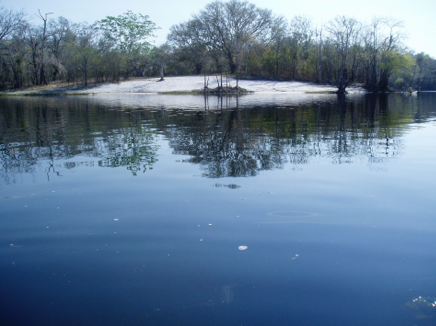
River Camp V to Gornto Springs County Park, March 12, 2009: I awoke about one o’clock. It was still warm. The moon was lower, but still lit the sandbar and river with its pale light. Even with the moonlight, I could see many stars. I could hear fish jumping in the river below. Way off in the distance I heard another Barred Owl calling as I drifted back to sleep. At five O’clock I awoke again, wedged against the downhill side of my tent. As I pushed myself upright and to the center, I discovered that sand had been slipping out from under my tent on the downhill side every time I moved, all night long. My quick fix was to take any loose gear I could find and stuff it under the low side of my sleeping pad to level it till morning. It worked. I slept soundly till seven o’clock and was up almost immediately. It was a warm and pleasant morning.
Packing up was a chore, as everything was coated with fine white sand, almost like powder. It stuck to everything. I took care to brush everything off. I didn’t want lots of sand in my hatches, nor did I want to take it home as a souvenir! Another quick breakfast and we were on the water at 9:05. We estimated the distance to Gornto Springs at seventeen miles. This would be one of out shorter days distance wise. (We actually paddled 18.5 miles.)
The river was calm and cool. Progress seemed a bit slower today than before. A check of the GPS showed that our push from the currant was less today than yesterday. This would continue as we drew closer to the Gulf of Mexico. The river was wider here, perhaps a thousand feet wide. The banks were lower and lined with trees and brush. There were no more limestone formations. And, there were many more camps and a few homes, though still many fewer than we would see on a similar river in the East.
We passed a group of feral pigs routing through the mud in a bank close by the river. Scott said there are lots of wild pigs in the south. They are escaped domestic stock that have become wild, like cats do if not living with humans. They can do a lot of damage. Most southern states hunt wild pigs to keep them under control.
The river was flat calm and reflected everything around it like a mirror set on a table. John startled another gator by the shore that exploded into the water near his boat and disappeared. Hawks and turtles, cormorants and black vultures, heron and kingfishers marked our progress down the Suwannee that morning. We passed the junction of the Suwannee and Santa Fe Rivers. The two rivers are distinctly different. The Suwannee is dark, almost black, stained by the tannin in the trees it flow by and round on its long trip from the Okefenoke Swamp in Georgia. The Santa Fe is much shorter. It’s waters run crystal clear making it easy to see to the bottom in deep water. I was surprised to see some really large fish that had been concealed in the dark waters of the Suwannee.
We had a hard time finding a place to pull out for lunch. There were no sandbars to be seen, not even a little flat bit of sand next to an open area where we could get out of the boats. And much more property here was posted against use by rabble such as us. Finally, Scott spotted a launching ramp, which appeared based on the signage to be public. It sat between two private cottages and was completely sun washed, except for a small spot of shade right in the center of the ramp. We didn’t have a lot of choice, so we pulled in and set up for lunch in the shady spot. We gave Scott a hard time about the fancy accommodation he had found for us.
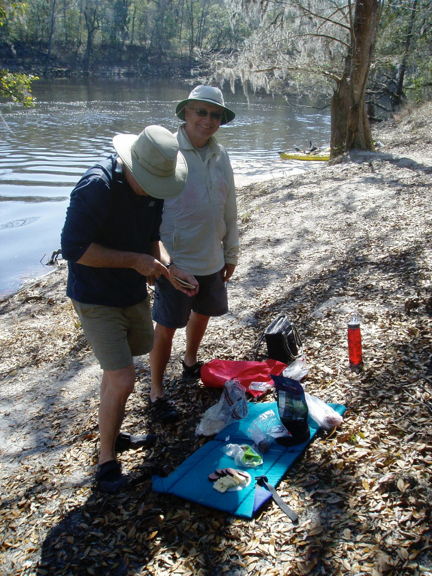
Lunch: Usually one person carries lunch for all of us for the whole trip. It is contained in a medium sized dry bag. I carry a zippered container with a sharp folding knife, a lighter, hand sanitizer, a spoon and a small cutting board. I often open my Crazy Creek chair and lay it flat as a platform for preparing our food out of the sand, dirt and debris of our lunch sites.
Lunch is usually simple. No one likes to eat too much as it makes for uncomfortable paddling later. On this trip we carried block cheese, summer sausage, pita bread, crackers, fresh apples and trail mix. Two or three slices of cheese and sausage, wrapped up in half a pita, and followed by a third of an apple is plenty to fill us up and give us energy for the afternoon. (We split one apple between us. It made the apples last for days and seemed to be enough to satisfy.) This is not a meal I would eat at home – too much fat! But that is precisely what makes it a good paddling lunch. The fat makes you satisfied with a small amount of food, while providing energy. Alternatives include hard boiled eggs (they keep pretty well, but crush easily), tuna pouches (I like the spicy tuna), peanut butter (everyone likes peanut butter) and bullion cubes for soup on cold days.
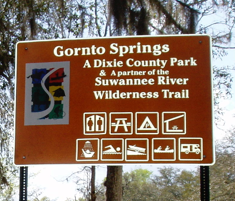
It didn’t take us too mush longer to reach the night’s camp - Gornto Springs. This is a Dixie County Park that is affiliated with the Wilderness Trail. It lacked the polish of the state sites. It appeared to be neglected. We pulled ashore next to a public boat ramp, where we tied our boats for the night. The landing adjacent to the boat ramp at Gornto Springs is shown below.
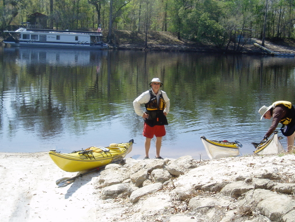
The camping area was in a marked open area under big trees. It provided plenty of shade. However, the end of the boat ramp aimed squarely at this area. It appeared that some boaters had pulled through the camping area in an effort to pull their boats out and leave. The designated camping spot wasn’t that close to the ramp. However, tire tracks indicated that it might be prudent to place a tree trunk between the ramp and our tents. Notice the tire tracks (foreground) in the photo below, leading directly toward our camping area.
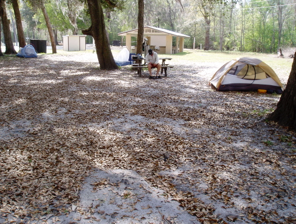
The park was busy. There were two women with two kids swimming over by the spring. Occasionally one of the women would light into one kid or the other. She had quite a mouth. The vocabulary those kids were learning would not help them out in school. Several times that afternoon a truck or old car would rattle into the park and pull up right next to the ramp, facing the river. The driver would just sit there, waiting for who knows what, sometimes with the vehicle idling loudly, sometimes sharing his exquisite taste in music with the park. It was never clear what they were there for, but they never stayed long before roaring off in a cloud of sand and dust.
We had arrived fairly early, so after the tents were set up, we each went off to do our own thing. Scott headed for the riverbank to continue with Napoleon. Unfortunately, every car and truck that stopped in the park that day pulled up right behind his chosen spot. This included the two potty-mouthed women, who I think were trying to teach Scott some new cuss words only know locally. John and I were at the picnic table, he working on a “black belt Su Doku” puzzle, while I wrote in my journal.
After a while, I wandered off to make a video of the park. The park had potential, but was in a state of neglect and disrepair. The bathrooms, which were designed for day use, were crudely made and dirty. There was no toilet paper in the dispensers; not a problem for through paddlers who come equipped, but an issue for day use folks. There were no soap or paper towels either, and everything was dirty, making it unpleasant to use.
The swimming area at the spring was in disrepair as well. The docks and swimming platforms were coming apart. A retaining wall on one side was crumbling. The grate at the spring’s outlet to the river was damaged, allowing for the possibility of at least small alligators entering the spring and swimming area. People had dropped trash and discarded clothing on the ground and docks. The spring itself was crystal clear but shallow. However, with the exception of a small open area on one side, the spring was choked with weeds. Still, it was a pretty place and adequate for our overnight purposes.
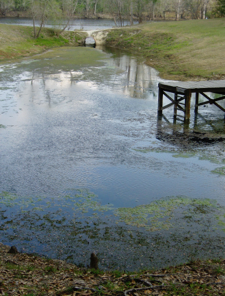
It was hot in the afternoon sun, so I decided to get wet in the spring. I avoided the dock and crumbling steps and slid down to the water on a steep bank. I piled my shoes and shirt on a rock and waded into the knee-deep water. The temperature was pleasant, so I sat down and got wet, staying there till I felt sufficiently cooled before climbing out to air dry in the sun. Scott wandered over to see what I was doing, then we headed back to camp to begin dinner.
While eating dinner, a late model Ford Mustang pulled into the park trailing a cloud of sandy dust. It drove right up to our table and sat there for what seemed like a long time. We looked at each other nervously, wondering what this was all about. Finally, a pencil thin man slowly climbed out of the driver’s seat, flicking ashes from his cigarette.
He stood there for the longest time, taking drags on his smoke, until he finally said, apologetically, “I’m the park manager. I’m supposed to collect a fee for camping from you guys.” We said that we knew about and expected to pay the fee, and had in fact been looking for some official to take our payment. The park manager (I think his name was Frank) seemed really embarrassed to take our money, but finally, he did. Then he slowly walked back to his car and hunted till he found his receipt book and an ancient pencil. He slowly made out a receipt for the money we had given him, all the while taking long drags on his cigarette. After finally handing the receipt to Scott, he stood there blowing clouds of smoke and staring into space. Then he coughed several times, flicked an ash on the ground and said, “Now you fellows have a good evening,” and drove off in the same cloud of sandy dust that had brought him to us.
Dark, accompanied by mosquitoes, came about 8 PM, when we all headed for our tents. After sorting gear and reading for a while, it was lights out for me at about 10 PM,. It was another warm night. I decided to sleep with one vestibule door pulled back. Somewhere nearby a pair of Barred Owls were carrying on a conversation as I drifted off to sleep.

Grotto Springs to Fanning Springs State Park, March 13, 2009: I’m awakened by loud voices. It’s 1:45 am. Headlights swing around, aimed right at my tent. I remember the tire tracks that pass through our camp. I sit straight up, straining to hear what is being said. Are these some local boys up to no good? I quickly pull on some long pants and poke my head out of the tent door. The headlights are blinding me. What are they up to? Are they going to run us over or steal our boats? The headlights lift and shoot over my tent, into the trees above as the truck backs down the boat ramp. These guys are launching a boat at 1:45 am? Why?
The loud talking and the banging of gear on the aluminum boat continued for some time. Eventually the truck pulled its empty trailer up the ramp and went off to park somewhere. The loud talking continued until an outboard motor roared to life and it and the voices disappeared down the river. A little shaken, I crawled out of the tent to relieve myself behind a nearby tree.
Quiet returned and so did sleep until 5 AM, when the roar and the voices returned. Once more there was banging and loud talk, headlights and the roar of the truck engine as it strained to pull the boat from the river. But eventually, the boat was loaded and these two old boys drove off into what would soon be dawn, seemingly oblivious to the fact that there were people attempting to sleep nearby. An hour and a half later I was up. It was still dark, so I stayed in my tent, packed up my gear and pouted. This last campsite of our trip was by far the least inviting. It was busy and really offered us no peace. I was so grateful for the other sites, especially River Camp V on the sandbar.
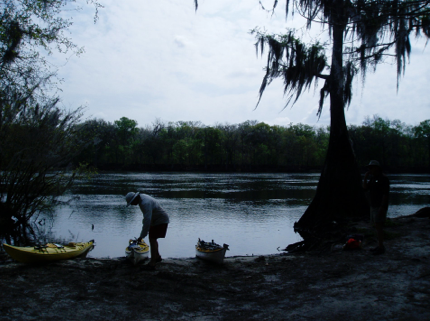
Another quick breakfast and we were on the river by 8:38 AM. I questioned Scott about what our nighttime visitors were up to. “Catfishing”, he said. “Night is the best time to go catfishing.” That was a real “duh” moment! So obvious, once you know about it.
I think we were anticipating the end of the trip. Our minds were already looking ahead to what we would need to do upon reaching our destination. As we paddled, it was clear that we were reaching areas of greater settlement. For the first time there were many powerboats. Some of them were big and fast. All the powerboats seen to this point had been small fishing boats of low horsepower, because the river was relatively narrow and shallow. And there were few of them. Now we saw more powerboats and more settlements. We began to see much bigger houses and stone walls right down to the water, walls that had been filled behind so that folks could have lawns. These walls represented a fight that couldn’t be won. The river constantly tugged at those structures. There were as many breakwalls eroded and collapsing as there were sound ones.
We grabbed a quick, fifteen-minute lunch at a private boat launch, then pressed on toward Fanning Springs State Park, arriving at 1:30. We had covered 21 miles in 4.5 hours. We spent a few minutes taking pictures and shaking hands to celebrate the end of our adventure, then Scott and I went to collect our cars.
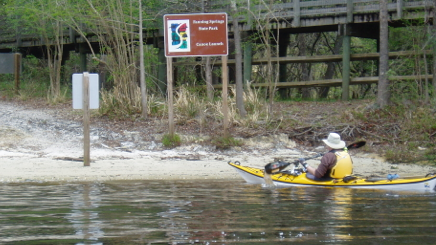
Yackman arriving at the canoe launch at Fanning Springs State State Park.
This was the endpoint for our trip, 138 miles from our start at White Springs, and about 60 miles from the town of Suwannee at the Gulf of Mexico. (Click here for endpoint video.)
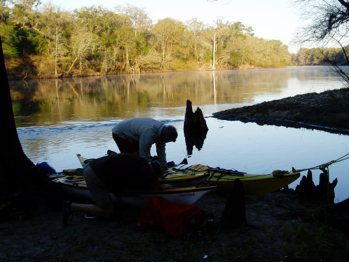
The cars were as we had left them, but dirty from the spring pollen bloom happening all around us. Next came the inevitable unloading of the boats and the hauling of gear up the trail to the cars. Gear was laid out and sorted for the trip home. Scott had time to kill, so he laid out all his gear to dry before heading for Cedar Key and some clients waiting there. Finally, we carried the boats to the cars and loaded my car with my boat and John’s before we handed Scott’s boat up to him at the top of his fifteen passenger van.
We said our goodbyes, vowing to do the upper Suwannee in Georgia next year. Then John and I climbed into the CR-V for the trip back to his car at the Suwannee Valley Campground in White Springs. John would collect his boat and gear and head back to relatives in Daytona. I thought I might stay the night at Suwannee Valley before heading north. But I wasn’t tired, so I showered, shaved and changed my clothes. At 6 PM I climbed into the CR-V once more, figuring I could drive for six hours or so before finding a place for the night.
